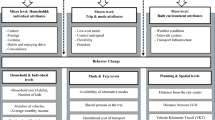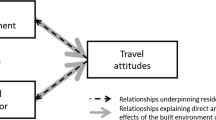Abstract
In recent years, increasing concerns over climate change, and transportation energy consumption have sparked research into the travel behavior, especially metro use. The aim of this research is to investigate the influences of objective factors (e.g. demographics, socioeconomics and daily travel features) and subjective factors (e.g. metro dependence and intention to reduce metro use) on metro mode choice behavior. A Structural Equation Modeling (SEM) framework was applied accounting for the mediating effect from car ownership in this study. Meanwhile, a comparison with the traditional model that ignores mediating role of car ownership and the proposed model was conducted. Using the travel survey data collected from Beijing, the metro use of 527 respondents was analyzed. Based on the model results, the influences of objective factors and the interaction effects between subjective factors and actual metro use were discussed. As for the objective factors, only the variables of high income and household size were found to have significant impacts on subjective metro dependence, intention to reduce metro use and actual metro use. Meanwhile, the results show that higher dependence on metro system enhances the actual metro use but decreases the intention of reducing metro use, and there is negative relationship between actual metro use and intention of reducing metro use. The results are expected to give transport policy makers a better understanding on how the influential factors impact metro mode choice, and consequently develop more effective and targeted countermeasures.
Similar content being viewed by others
References
Ajzen, I. (1991). “The theory of planned behavior.” Organizational behavior and human decision processes, Vol. 50, No. 2, pp. 179–211, DOI: 10.1016/0749-5978(91)90020-T.
Bamberg, S., Rö lle, D., and Weber, C. (2003). “Does habitual car use not lead to more resistance to change of travel mode?” Transportation, Vol. 30, No. 1, pp. 97–108, DOI: 10.1023/A:1021282523910.
Baum-Snow, N. and Kahn, M. E. (2000). “The effects of new public projects to expand urban rail transit.” Journal of Public Economics, Vol. 77, No. 2, pp. 241–263, DOI: 10.1016/S0047-2727(99)00085-7.
Baum-Snow, N., Kahn, M. E., and Voith, R. (2005). “Effects of urban rail transit expansions: Evidence from sixteen cities, 1970-2000 [with Comment].” Brookings-Wharton Papers on Urban Affairs, pp. 147–206, DOI: 10.1353/urb.2006.0001.
Browne, M. W., and Cudeck, R. (1992). “Alternative ways of assessing model fit.” Sociological Methods & Research, Vol. 21, No. 2, pp. 230–258, DOI: 10.1177/0049124192021002005.
Byrne, B. M. (2013). Structural equation modeling with AMOS: Basic concepts, applications, and programming. Routledge, London.
Ding, C., Liu, C., Lin, Y., and Wang, Y. (2014a). “The impact of employer attitude to green commuting plans on reducing car driving: A mixed method analysis.” PROMET-Traffic & Transportation, Vol. 26, No. 2, pp. 109–119, DOI: 10.7307/ptt.v26i2.1332.
Ding, C., Lin, Y., and Liu, C. (2014b). “Exploring the influence of built environment on tour-based commuter mode choice: A crossclassified multilevel modeling approach.” Transportation Research Part D: Transport and Environment, Vol. 32, pp. 230–238, DOI: 10.1016/j.trd.2014.08.001.
Ding, C., Wang, Y., Yang, J., Liu, C., and Lin, Y. (2015). “Spatial heterogeneous impact of built environment on household auto ownership levels: Evidence from analysis at traffic analysis zone scales.” Transportation Letters, 2015 published online. DOI: 1942787515Y-0000000004.
Donovan, J. E. (1993). “Young adult drinking-driving: Behavioral and psychosocial correlates.” Journal of Studies on Alcohol and Drugs, Vol. 54, No. 5, pp. 600–601, DOI: 10.15288/jsa.1993.54.600.
Friman, M. and Gärling, T. (2001). “Frequency of negative critical incidents and satisfaction with public transport services. II.” Journal of Retailing and Consumer Services, Vol. 8, No. 2, pp. 105–114, DOI: 10.1016/S0969-6989(00)00004-7.
Gao S., Mokhtarian, P. L., and Johnston, R. A. (2008). “Exploring the connections among job accessibility, employment, income, and auto ownership using structural equation modeling.” Annals of Regional Science, Vol. 42, pp. 341–356, DOI: 10.1007/s00168-007-0154-2.
Gallarza, M. G. and Saura, I. G. (2006). “Value dimensions, perceived value, satisfaction and loyalty: An investigation of university students’ travel behavior.” Tourism Management, Vol. 3, No. 27, pp. 437–452, DOI: 10.1016/j.tourman.2004.12.002.
Golob, T. F. (2003). “Structural equation modeling for travel behavior research.” Transportation Research B: Methodological, Vol. 37, No. 1, pp. 1–25, DOI: 10.1016/S0191-2615(01)00046-7.
Jakobsson, C., Fujii, S., and Gärling, T. (2000). “Determinants of private car users’ acceptance of road pricing.” Transport Policy, Vol. 7, No. 2, pp. 153–158, DOI: 10.1016/S0967-070X(00)00005-6.
Kitamura, R., Mokhtarian, P. L., and Laidet, P. (1997). “A micro-analysis of land use and travel in five neighborhoods in the San Francisco Bay Area.” Transportation, Vol. 24, No. 2, pp. 125–158, DOI: 10.1023/A:1017959825565.
Kockelmank, M. (1997). “Travel behavior as function of accessibility, land use mixing, and land use balance, evidence from San Francisco Bay Area.” Journal of the Transportation Research Board, Vol. 1607, No. 1, pp. 116–125, DOI: 10.3141/1607-16.
Krizek, K. J. (2003). “Residential relocation and changes in urban travel: Does neighborhood scale urban form matter?.” Journal of the American Planning Association, Vol. 69, No. 3, pp. 265–281, DOI: 10.1080/01944360308978019.
MacCallum, R. C., Browne, M. W., and Sugawara, H. M. (1996). “Power analysis and determination of sample size for covariance structure modeling.” Psychological methods, Vol.1, No. 2, pp. 130, DOI: 10.1037/1082-989X.1.2.130.
Morikawa, T. and Sasaki, K. (1998). “Discrete choice models with latent variables using subjective data.” Travel Behavior. Research: Updating the State of Play, Pergamon, Oxford, pp. 435–455, DOI: 10.1016/B978-008043360-8/50024-8.
Mokhtarian, P. L. and Gao, X. (2008). “Examining the impacts of residential self-Selection on travel behavior: Methodologies and empirical findings.” Transportation Research Part B: Methodological, Vol. 3, No. 42, pp. 204–228, DOI: 10.1016/j.trb.2007.07.006.
Shi, G. (2014). Metro fares will be adjusted in Beijing before the end of October 2014 (Chinese), retrived at: http://news.xinhuanet.com/photo/2014-04/22/c_126416755.html.
Van, A. V. and Witlox, F. (2010). “Car ownership as a mediating variable in car travel behavior research using a structural equation modeling approach to identify its dual relationship.” Journal of Transport Geography, Vol. 18, No. 1, pp. 65–74, DOI: 10.1016/j.jtrangeo.2009. 05.006.
Zhang, Q., Han, B., and Li, D. (2008). “Modeling and simulation of passenger alighting and boarding movement in Beijing metro stations.” Transportation Research Part C: Emerging Technologies, Vol. 16, No. 5, pp. 635–649, DOI: 10.1016/j.trc.2007.12.001.
Zhao, J. (2011). “Subjective measure of car dependence.” Journal of the Transportation Research Board, Vol. 2231, No. 1, pp. 44–52, DOI: DOI: 10.3141/2231-06.
Author information
Authors and Affiliations
Corresponding author
Rights and permissions
About this article
Cite this article
Zhu, Y., Wang, Y. & Ding, C. Investigating the influential factors in the metro choice behavior: Evidences from Beijing, China. KSCE J Civ Eng 20, 2947–2954 (2016). https://doi.org/10.1007/s12205-016-0399-3
Received:
Accepted:
Published:
Issue Date:
DOI: https://doi.org/10.1007/s12205-016-0399-3




